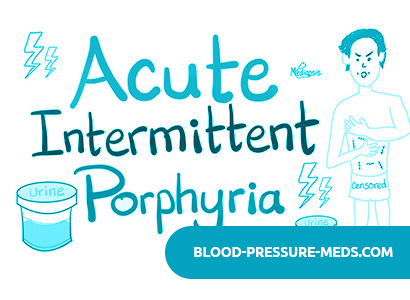What is Acute Intermittent Porphyria?
Acute intermittent porphyria is a genetically determined disease caused by damage to the central nervous system, less commonly the peripheral nervous system, recurrent abdominal pain, increased blood pressure and pink urine due to a large number of porphyrin precursors.
Causes of Acute Intermittent Porphyria
The disease is genetically determined, is transmitted by an autosomal dominant type.
More often, the disease affects young women and girls and is triggered by pregnancy and childbirth. It is also possible the development of the disease as a result of taking a number of drugs, such as barbiturates, sulfa drugs, analgin. The most frequent exacerbations are observed after operations, especially if thiopental sodium was used for sedation.
Pathogenesis during Acute Intermittent Porphyria
The disease is based on the violation of the activity of the enzyme uroporphyrinogen I-synthase, as well as an increase in the activity of synthase 6-aminolevulinic acid.
Clinical manifestations of the disease are characterized by the accumulation in the nerve cell of a toxic substance 8-aminolevulinic acid. This compound is concentrated in the hypothalamus and inhibits the activity of brain sodium-potassium-dependent adenosine phosphatase, which leads to disruption of ion transport through the membranes and disrupts nerve function.
Further develop demyelination of the nerves, axonal neuropathy, which causes all clinical manifestations of the disease.
Symptoms of Acute Intermittent Porphyria
The most characteristic sign of acute intermittent porphyria is abdominal pain. Sometimes severe pain is preceded by delayed menstruation. Often patients are operated on, but they do not find the cause of the pain.
In acute porphyria, the nervous system is affected by the type of severe polyneuritis. It begins with pain in the limbs, difficulties in movements associated with both pain and symmetrical movement disorders, especially in the muscles of the limbs. If the muscles of the wrist, ankles, hands are involved in the pathological process, then almost irreversible deformities can develop. With the progression of the process, paresis occurs in the four limbs, further possible paralysis of the respiratory muscles and death.
The central nervous system is also involved in the process, as a result of which seizures, epileptiform seizures, delirium, hallucinations appear.
In most patients, blood pressure rises, severe arterial hypertension is possible with an increase in both systolic and diastolic pressure.
The doctor should stop taking some seemingly innocuous drugs, such as valocordin, bellaspon, belloid, theofedrin, containing phenobarbital, which can exacerbate the disease. The aggravation of this form of porphyria also occurs under the influence of female sex hormones, antifungal drugs (griseofulvina).
Severe neurological disorders are often the cause of death, but in some cases the neurological symptoms subside, and later remission occurs. In connection with such a characteristic clinical picture of the disease, it was called acute intermittent porphyria.
It should be noted that far from all carriers of the pathological gene, the disease manifests itself clinically. Often, relatives of patients, especially men, have biochemical signs of the disease, but there are no and no clinical symptoms. This is a latent form of acute intermittent porphyria. In such people, when exposed to adverse factors, severe exacerbation can occur.
Diagnosis of Acute Intermittent Porphyria
Diagnosis of acute intermittent porphyria is based on the detection in the urine of patients with the precursors of porphyrin synthesis (the so-called porphobilinogen), as well as 6-aminolevulinic acid.
Differential diagnosis of acute intermittent porphyria is carried out with other, more rare, forms of porphyria (hereditary coproporphyria, variegated porphyria), as well as lead poisoning.
When lead poisoning is characterized by abdominal pain, polyneuritis. However, lead poisoning, in contrast to acute porphyria, is accompanied by hypochromic anemia with basophilic red blood cell puncture and high serum iron content. Anemia is not characteristic of acute porphyria. In women suffering from acute porphyria and menorrhagia, chronic post-hemorrhagic iron deficiency anemia is possible, accompanied by a low content of serum iron.
Treatment for Acute Intermittent Porphyria
First of all, should be excluded from the use of all drugs that lead to the exacerbation of the disease. You should not appoint patients with analgin, tranquilizers. With severe pain, narcotic drugs, aminazin are indicated. With a sharp tachycardia, a significant increase in blood pressure, it is advisable to use inderal or obzidan, with pronounced constipation – prozerin.
A number of drugs (primarily glucose) used in acute intermittent porphyria, aimed at reducing the production of porphyrins. A high carbohydrate diet is recommended, concentrated glucose solutions (up to 200 g / day) are administered intravenously.
The introduction of hematin gives a significant effect in severe cases, but the drug sometimes causes dangerous reactions.
In severe cases of acute porphyria, in case of respiratory failure, patients need long-term controlled ventilation of the lungs.
In the case of positive dynamics, as well as with a marked improvement in the condition of the patients, massage, therapeutic gymnastics are used as rehabilitation therapy.
In remission, prophylaxis of exacerbations is necessary, especially the exclusion of agents that cause exacerbations.
The prognosis in case of damage to the nervous system is quite serious, especially when using artificial respiration.
If the disease proceeds without severe violations, the prognosis is quite good. Often it is possible to achieve remission in patients with severe tetraparesis, mental disorders. It is necessary to examine the relatives of patients to identify the biochemical signs of porphyria. All patients with a latent form of porphyria should avoid drugs and chemicals that cause exacerbation of porphyria.

